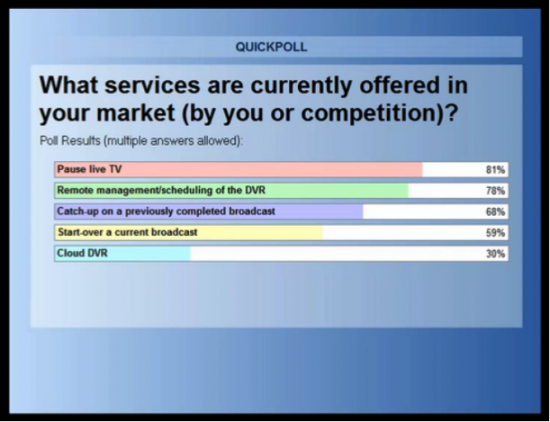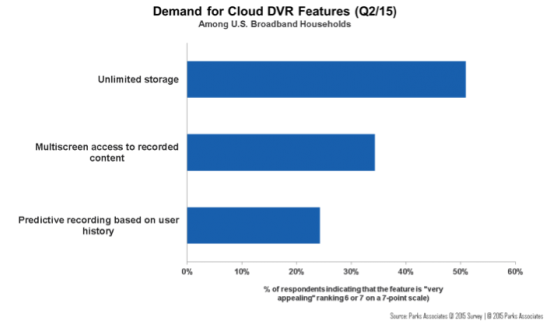































A few years ago, the idea of cloud-based digital video recording (DVR) was an aspiration. Today, while the technology is still relatively new, it's already seeing broad adoption in the market. In a recent webcast conducted with Parks Associates, attendees revealed the breadth of cloud-based services they were already using to catch up on TV content. From basic "pause live TV" features to full cloud DVR, check out the range of cloud services already available:

There are lots of good reasons operators are moving so quickly to roll out these types of services. First, consumers want it.According to the Cisco Visual Networking Index (VNI), time-delayed TV will be the fastest-growing residential service by 2019. Additionally, the ability to offer unlimited storage-something that's impossible with a traditional set-top DVR-is the cloud DVR feature that resonates most with consumers. A recent Parks Associates survey found that over 50% of U.S. pay-TV subscribers find unlimited storage very appealing.

But cloud-based services can also offer pay-TV providers huge operational benefits as well.
By moving from a service that's tied to the capabilities of the in-home architecture to one that's powered from the cloud, operators can reach many more screens without expensive on-premises hardware and local storage-extending their service reach to virtually any video-enabled consumer device. More importantly, operators gain greater flexibility to up-sell users instead of boxes for cloud-delivered DVR services. Additional benefits include simplifying the operations for provisioning and managing video services, and reduced costs by using the same virtualized video resources to deliver their live, VoD, Time-Shift and Cloud DVR services.
That's all good news, and it's no wonder that so many in the pay-TV industry are talking about it. But what people don't seem to be talking about is how big of a change this is. If you think Cloud DVR is just about moving recording and storage to the cloud, think again.
A Powerful Combination
Early cloud-based DVR and catch-up TV services focused on providing elastic recording and storage capabilities that are impossible to achieve with an architecture tied to the set-top box (STB) in the home. But shifting content scheduling and recording management to the cloud, and enabling individual users to record and play back content on their devices inside and outside the home, introduces an entirely new level of complexity.
Moving traditional DVR functions from the STB to the cloud affects a wide range of policy and business management systems that are tied to cloud-based video recording, storage, and playback functions. Since the DVR serves as a bridge between the linear broadcast world and the on-demand world sought by consumers, the functions of a cloud DVR necessarily touch upon both of these areas too.
It's the combination of an intelligent and dynamic policy management system with an elastic video processing infrastructure in the cloud that allows service and content providers to unlock the infinite flexibility of cloud DVR. When you have that combination, you can do things like:
Cloud-based recording and storage can't fully address this opportunity on their own. Fortunately, Cisco is delivering an end-to-end Cloud DVR platform that can. We're bringing greater back-end intelligence to elastic cloud recording, storage, and playback capabilities to make the infinite possibilities of cloud DVR a reality.
To get a better sense of what's needed to move DVR functions to the cloud, check out the recent Parks Associates webcast and white paper.
Have questions or comments? Tweet @CiscoSPVideo to learn more!
 Tags quentes :
service providers
Cisco VNI
cloud dvr
dvr
VOD
Pay TV
cloud-based services
Tags quentes :
service providers
Cisco VNI
cloud dvr
dvr
VOD
Pay TV
cloud-based services